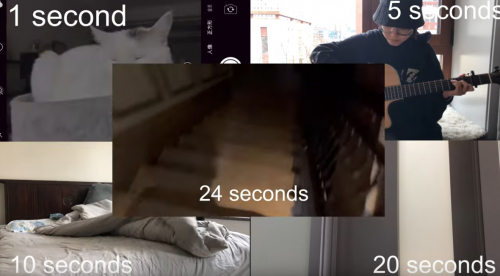Play & Time:
Theme: Time
Context:
This theme reminds me of when I was in elementary school, my teacher led us in a game. He had all of us lie at our desks, close our eyes, and feel the length of a minute. If you felt the minute was up, you could lift your head up. When I was lying down, I didn't check the numbers, my mind went blank. When I felt it was almost a minute, I lifted my head up, but in reality, the minute hadn't arrived at that point. One by one, the students put their heads up at different points in time. Each with their own idea of the length of a minute in mind. People's perception of time could be changed. Maybe what you think is a minute is not really a minute. This is the earliest time-related game I have ever played, this game brought me inspiration.
Method:
My idea is to segment the time. Find out what I think I can do in one second, five seconds, ten seconds, twenty seconds, twenty-four seconds. Then correspond to do it, record the time, and finally add it together to see if it is one minute.
Response:https://youtu.be/eSFTWN4tusc
Time is often used in games and animation. For example, in the Rabbids Adventure Party(developed by Ubisoft Chengdu Studio), there is a level that requires people to guess the length of time as accurately as possible. The more accurate the guess, the higher the score. This game has even been used in daily life. Some restaurants will set up time-guessing machines. If people can guess the time accurately, they can eat this meal for free.
I try to visualize time. Using people's inherent thinking to feel time, the results also show that the time in our mind is different from real-time. This can also be well used in the game. For example, complicating a thing that can be completed quickly by instinct. When people think they have only played a game for five minutes, it may have been ten minutes, which can increase the game duration of players. In Zelda's breath of wild, the player's task may only be to talk to NPC, but increasing the distance and the number of monsters increases the complexity of this process and increase the length of the game.
Serres argues that conceiving of time linearly commits us to the belief that progress itself is a deterministic and oftentimes violent series of upheavals. Contemporary video games that play with time seem to exemplify this. Games like Braid, Assassins Creed, and Prince of Persia: The Sands of Time have players manipulate time for the explicit purpose of reproducing a singular narrative, compelling players to synchronize their decisions with a violent, linear series of events. However, time in the game can also be multi-dimensional and can be artificially shaped into nonlinearity. A timeline can be divided into multiple lines, and the time flow rate of each branch line can also be different. Just like Nolan's Dunkirk and FPS game superhot, the time in artworks can be fast or slow and even show what happens simultaneously in one minute, one hour, and one day at the same time. Events are interleaved through editing, In front of the audience or players in an intertwined and intertwined state, it brings a different audio-visual feeling.
Reference:
Wilcox, S. (2018). Illusions of space and time: An ethical approach to temporality in games. Journal of Gaming and Virtual Worlds, 10(2), 115-133. doi:http://dx.doi.org/10.1386/jgvw.10.2.115_1
Moran, C. W. (2013). Interactive time (Order No. 3567600). Available from ProQuest One Academic; Social Science Premium Collection. (1420350779). Retrieved from https://login.ezproxy.lib.rmit.edu.au/login?url=https://www.proquest.com/dissertations-theses/interactive-time/docview/1420350779/se-2?accountid=13552
About This Work
By Yuxin Liu (Robin)
Email Yuxin Liu (Robin)
Published On: 04/04/2022
